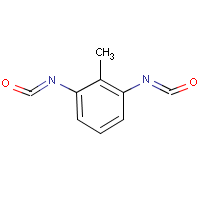Toluene-2,6-diisocyanate
Agent Name
Toluene-2,6-diisocyanate
Alternative Name
2,6-TDI
CAS Number
91-08-7
Formula
C9-H6-N2-O2
Major Category
Plastics & Rubber

Synonyms
1,3-Diisocyanato-2-methylbenzene; 2,6-Diisocyanato-1-methylbenzene; 2,6-Diisocyanatotoluene; 2,6-TDI; 2-Methyl-meta-phenylene isocyanate; Benzene, 1,3-diisocyanato-2-methyl-; Benzene, 2,6-diisocyanato-1-methyl-; Isocyanic acid, 2-methyl-meta-phenylene ester; 2,6-Toluene diisocyanate; Tolylene 2,6-diisocyanate; UN2078; m-Tolylene diisocyanate; meta-Tolylene diisocyanates; [ChemIDplus]
Category
Diisocyanates
Description
Colorless to pale-yellow liquid with a sharp, acrid odor; [ACGIH]
Sources/Uses
Occupational asthma reported in floor varnishers and in workers manufacturing polyurethane foams and elastomers; [Malo]
Comments
No major toxicological differences between the various isomers and commercial mixtures of TDI; TLV Basis: asthma; pulmonary function; eye irritation; [ACGIH] See "Toluene-2,4-diisocyanate."
Reference Link #1
Biomedical References
Exposure Assessment
BEI
Toluene diamine in urine (with hydrolysis) = 5 ug/g creatine at end of shift; [TLVs and BEIs]
Skin Designation (ACGIH)
Yes
TLV (ACGIH)
0.001 ppm, inhalable fraction and vapor
STEL (ACGIH)
0.005 ppm, inhalable fraction and vapor
PEL (OSHA)
Ceiling(OSHA) = 0.02 ppm
MAK
0.001 ppm
IDLH (NIOSH)
2.5 ppm
Vapor Pressure
0.0209 mm Hg
Odor Threshold Low
0.05 ppm
Explanatory Notes
Odor threshold = 50 ppb with about 1/2 of volunteers detecting and identifying the material at 400 ppb; [ACGIH] VP from ChemIDplus;
Reference Link #2
Adverse Effects
Skin Sensitizer
Yes
Asthma
Yes
Lachrymator
Yes
Toxic Pneumonitis
Yes
Fibrogenic
Yes
Dermatotoxin
Skin burns
IARC Carcinogen
Possible (2b)
NTP Carcinogen
Anticipated human carcinogen
ACGIH Carcinogen
Confirmed Animal
Diseases, Processes, and Activities Linked to This Agent
Diseases
Occupational diseases associated with exposure to this agent:
Processes
Industrial Processes with risk of exposure: